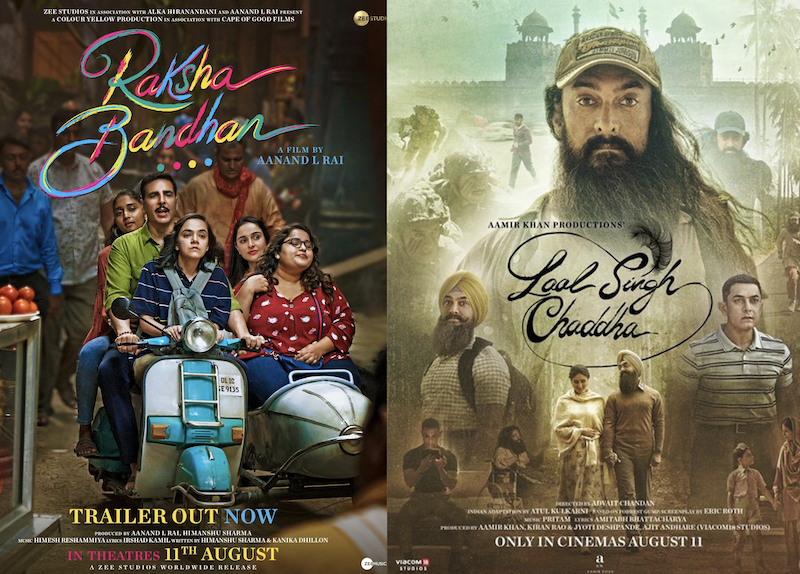


By Gautam Jain
Over the last few months, every time a Hindi film underperforms at the box office, there is increased chatter about Bollywood’s impending death. Mainline media, trade experts, and the social media at large, is quick to conclude that “Bollywood has lost the plot”, and that “South movies have taken over Hindi cinema”. The nature of this commentary is not surprising. After all, pessimism sells like hot cakes, while optimism has few takers.
Various reasons have been presented for Hindi cinema’s under-performance in 2022, only some of which are valid. While it is true that only a handful of Hindi films have delivered at the box office this year, the situation is not very different for films in languages like Tamil, Malayalam, Kannada or Telugu. In fact, the Telugu film industry had to halt production for a few weeks to go back to the drawing board, taking cognisance of the under-performance.
Before calling the curtains on an industry that has played a huge role in entertaining audiences worldwide for more than 100 years, and has become a socio-cultural beacon for our nation worldwide, it is important to understand the present situation from a more macro perspective.
This is not the first time the Hindi film industry is facing existential crisis. The industry faced similar challenges in the early 70s, in the late 80s, as well as in the early 2000s.
By late 60s, the trio of Dilip Kumar, Dev Anand and Raj Kapoor, who were ruling the box office through the 50s and the 60s, had started phasing out of popular films. The romance genre, with soulful melodies and beautiful locations being its highlights, had started to feel jaded. Rajesh Khanna, who had a string of successful films, was suddenly thrown off-guard with in the early 70s with back-to-back flops. While the audience’s needs for entertainment had changed, filmmakers were yet to take note of it, till a film, Zanjeer, paved the way for them. Then, there was no looking back for the next decade or so. But by the mid 80s, the same films started looking formulaic, and failed to win audience love. Once again, a few films (such as Qayamat Se Qayamat Tak and Maine Pyaar Kiya) ushered in a new era, forcing filmmakers to acknowledge the change in the audience taste.
With the onslaught of VCDs and DVDs came the huge issue of piracy in the early 2000s. While wider digital distribution resolved this issue to some extent, the industry still loses a lot of money to piracy. But that has not killed the industry.
What we are witnessing now is not a trend that has started with just a couple of films like Pushpa, RRR or K.G.F: Chapter 2. It was brewing since 2018-19. While the box office was growing due to increase in ticket prices, footfalls were stagnant for a couple of years. While box office looked healthy because a few films outperformed, the Hindi film-going audience universe was actually shrinking. Audiences had already become extremely selective about their theatre visits. The COVID-led lockdown, and the related growth of streaming, just accelerated this audience change to its tipping point.
We are witnessing a decadal shift in content consumption. Cinema, in Hindi or any other language, is not dead. But a change in content strategy is imperative for the industry to get back on its feet. The current situation also presents a great opportunity for the industry to start afresh, and address some foundational issues which otherwise would have gone unnoticed. Here are my thoughts on the steps the Hindi film industry can take, to get back to winning audience’s hearts at the box office.
Content
Herd mentality: If we look at the content produced by the Hindi film industry over the last 10 years, some clear patterns emerge. From 2010 to 2014, there were primarily action films, remade from Tamil or Telugu languages, commissioned after the success of Wanted and Dabangg. 2013-14 onwards saw the focus shift to biopics (after Bhaag Milkha Bhaag) and women empowerment themes (after Kahaani and Queen). This rush to replicate what has worked in the recent past generally leads to a sudden overdose of specific genres, killing the genre’s potential. Similar is the case with actor-genre combinations: Ayushmann Khurrana’s frequenting of the social message-based comedy genre has led to fatigue, not just of the genre but for the actor as well, impacting his box office pull as a result.

Message over entertainment: Many Hindi films, post 2014, have tried hard to push a message along with their story. When done well, a story with a message works wonders. But often, this messaging overtakes the story, and the films move from being entertaining to being preachy. And who likes to be taught life lessons when they are paying for entertainment?
Lip sync and in-film songs: Many new-age filmmakers look down upon the presence of songs in their films, especially lip sync songs. A basic analysis of the top 10 films from 2000 to 2019 shows us that the presence of songs have been on a decrease in Hindi cinema. For Indian films, music has been a differentiator for many years. Apart from being a content differentiator, songs also work as key marketing assets, especially for the youth, who form a sizeable chunk of the opening day and opening weekend audience. The Chinese don’t change their storytelling because they are releasing their film worldwide. Korean cinema is known all over the world for their gory portrayal of crime and violence. They haven’t changed their films to suit Western sensibilities. Instead, the West, and the whole world, has accepted their cinema just as it is. The wide acceptance and love for RRR worldwide is a reminder that we need to embrace our differentiators. And music is certainly one of them.
Critical acclaim or audience likeability: Audience appreciation results in increasing footfalls in cinema halls over a period of time. But no amount of critical acclaim (or the lack of it) can impact footfalls. Still, many films are greenlit with the critics in mind. The choice must be made clearly while green-lighting a script: Is it being made for critical acclaim, or for audience appreciation? The choice, once made, should then determine the budget. You cannot make a film only for critical acclaim, at the budget of a box-office blockbuster.
Marketing
Marketing to the audience, and not to vanity: Hindi film marketing has been fairly templatised over the last few years. TV show integrations, city tours, mall and college visits, digital campaigns, the outdoor blast, the print splurge, the works. The question to ask is: Is the marketing money being spent moving anything in the film’s favor? Or is the money being spent purely to showcase the key cast and crew, promoting their individual brands, instead of the film itself? The answers are easy, but also difficult to implement. It is difficult to tell a star that the film doesn’t need a paid front-page article or a 10-city tour. But for studios that are spending huge budgets to market their films, the need of the hour is to evaluate any marketing option for its return on investment.
Controversies don’t help: It has been general wisdom that controversies would lead to more talk about the film, and therefore increased buzz. Barring a few exceptions, this has not proven to be beneficial to a film’s box office prospects. We still see films embroiled in one or the other controversy, organic or inorganic. It may not always be in the control of the filmmaker to stop them, but one can try to avoid them wherever possible.
Push or pull: Perhaps the biggest concern regarding Hindi film marketing today is that almost all of it has become push marketing instead of pull marketing. The more one tries to sell to the audience, the more evasive they become. But when one tries to work on the messaging being right for the film’s core TG, the campaign manages to pull them to the cinema halls. The difference may be hard for many to notice and tough to execute, but when done well, it leads to record-breaking openings.
Distribution
There’s room for everyone: A Marvel film and a DC film will never release on the same day. Across all key holiday periods, Hollywood films spread their releases with a gap of at least a week, often two. It is only in India that we see two or three, or in some languages, upto four, major films releasing on the same holiday. These clashes don’t help anyone. They decrease the overall box office potential of each film involved, and then lead into lull weeks when there are no significant releases. A regular Hindi film audience watches an average of 6-7 films in theatres in a year. Can we expect them to watch two of these 6-7 on the same weekend?

Box office, the only revenue source that should matter: Relying on non-theatrical revenues will not help in long term. Be it VHS or DVD rights in the past, music or satellite rights, or the more-recent streaming rights, we have seen that at the end of the day, theatrical collections eventually determine whether a film is profitable or not. Streaming rights have been the savior for many films recently, but that won’t be the case going ahead. Eventually, the industry will prosper only if they see theatrical business as the only revenue source, with everything else being like an icing on the cake.
A wider release does not equal larger box office: To increase supply, there needs to be sufficient demand. When a film runs at an occupancy of 10% on a 500-screens release, why does it need 2000 screens? There is an “India is under-screened” argument that’s been around for a few years now. But how would more screens help if only about three films a year are suited to the taste of many of the new screens that come up, generally outside the metros and the mini-metros? A city multiplex can survive on 20% occupancy, but in smaller towns and single screens, one needs consistent footfalls to keep the ship running. When the content pipeline is strong and consistent, exhibitors would have the confidence of investing in renovating their cinemas, improve services, and eventually, build a loyal audience base.
Looking beyond the diaspora for overseas business: Hollywood has done it over the years world over, including in India. From the first Iron Man film that struggled to get a ₹ 20 Cr gross, to Avengers Endgame getting one of the highest openings ever in India, it is possible to build a loyal fan base for films in other countries. But this will need consistent effort from all stakeholders - studios, distributors, actors, etc. Hindi cinema's box office contribution from overseas box office has not increased over the last 7-8 years. The top blockbusters still collect the same amount overseas that they did about a decade or two ago. Distribution and marketing efforts in overseas for most films have been limited to targeting the diaspora, which itself has evolved over the years, making it difficult to grow the overseas box office.
Exhibition
Footfalls (long-term) vs Ticket Price (short-term): We can grow the box office by increasing ticket prices (which is how the Hindi box office grew from 2015 to 2019), or we can grow the box office by increasing footfalls (like it happened in the 70s). The choice is to let go of the incremental revenue right now, for the larger good of the industry at a later stage. Increasing footfalls will lead to a long-term advantage. Once consumption of a media becomes a habit, it becomes tough to break. We saw the huge bump in footfalls on the National Cinema Day on September 23 this year. But a one-off day will not create a habit. A larger, more sustained effort to control ticket prices at an industry level (like the Telugu film industry) is needed.
The Indian consumer is extremely price sensitive. It has taken MNCs across categories years of patience, hard work and sound strategy to make inroads into the consumer’s buying pattern. There is no shame in a film’s ticket being priced at ₹ 100 or 125. After all, the audience does not assign a certain stature to a film based on its ticket price.
Clean, family-friendly theatres: Not all audiences need state-of-the-art multiplexes in their towns, but the necessity of clean theatres which can be visited with families, especially women, is a basic. It is a Catch 22, since exhibitors don’t improve services due to a lack of audience, and audience doesn’t walk in due to a lack of services.
Talent
Need for talent diversity: In the 70s, we had writers, directors, actors and technicians from all parts of India working in the film industry. Each one of them brought their own unique sensibilities to their craft, leading to a variety of content being offered to the audience. This diversity of representation is missing in the Hindi film industry today. Most of our contemporary filmmakers are born and raised in Mumbai (or other metros cities), with lesser exposure to the width and depth of our extremely diverse nation. Even the films based in the Hindi heartland invariably don’t work in that region itself. Many filmmakers’ and actors’ idea of India is largely based on secondary information, rather than individual experiences and first-hand observation. Many people working in the Hindi film industry actually find it difficult to speak Hindi language themselves. Tamil, Telugu, Malayalam and Kannada industries take pride in their language and their heritage, which keeps them rooted to their audience.
Directors and writers: The 70s saw the consolidation of professional film writers, i.e., people who were only writing, and not directing those films too. This also led to multiple writer-director combos, which churned out blockbusters, one after the other. Today, many directors are writers themselves. There is nothing fundamentally wrong with a director writing their films, but an aspect where this dual role falters is the inability to see a different perspective, or a flaw in one’s own work.
Respect and pay for the writers: As a part of our work, one has been privy to a few film budgets, and what the writers get paid is not flattering at all. In a particular budget, the collective fee charged by the hair and make-up personnel was more than that of the writers. It’s very rare to see a writer being called on the stage at a trailer launch, or in a show like Kapil Sharma’s. A writer’s mind will be the first to notice how our society is evolving, the issues that are dominating the mindspace of the target audience, the kind of stories that are likely to resonate with them, etc. Without due respect and fair remuneration to the writers, we are weakening on a crucial cog in the wheel.
Star fees to budget ratio: Can a star’s remuneration be linked to their box office performance? There are only a few genuine stars, and most of them do less than a film a year. High remuneration of stars, both genuine and media-created, often makes film budgets inviable. There have been multiple instances where a star’s fee for a film is more than his last film’s lifetime box office (and many more where it’s more than the distributor share of his last film). In turn, this can lead to undercutting production budgets, leading to sub-standard products. Linking star remuneration to box office performance is a good model to de-risk a film.
More films from top directors and actors: From the 52 weeks in a year, a mainstream film industry needs at least 20 films to keep the box office in good shape. But most of our top stars are acting in only one film in a year. The top directors like Sanjay Leela Bhansali or Rajkumar Hirani take 3-5 years to make a film. In a situation like this, where survival is at stake, we need more output from this top brass.
Exclusivity: When a leading film star is accessible on Facebook, Instagram, Twitter, in multiple ads across television and digital media, and on television shows, why should the audience feel the urge to go and watch the same star on the big screen? Hindi films stars can learn to balance this aspect from their counterparts in the Tamil and Telugu industries. It is not wrong to promote brands, host TV shows, or be present on social media. But the incessant presence, on social media in particular, causes the exclusivity to diminish. The mystery and the aura of a big-screen star is not well served when we can watch him or her in back-to-back reels on Instagram, right?
Here's hoping the Hindi film industry (and the Indian film industry, at large) comes out of this dull phase, re-aligns itself to changing audience needs and behaviour, and emerges stronger again.

The India Box Office Report: October 2025
Driven by Kantara - A Legend: Chapter-1, October 2025 has emerged as the highest-grossing box office month of the year at the India box office, with gross collections of ₹1,669 Cr

Venn It Happens: SVOD & Theatrical audience intersection
The second edition of our new feature Venn It Happens illustrates the intersection between SVOD and Theatrical audiences in India, using data from Ormax Media's industry reports

Ormax Cinematix's FBO: Accuracy update (October 2025)
This edition of our monthly blog summarises Ormax Cinematix's box office forecasts (FBO) for all major October 2025 releases vis-à-vis their actual box-office openings
Subscribe to stay updated with our latest insights
We use cookies to improve your experience on this site. To find out more, read our Privacy Policy